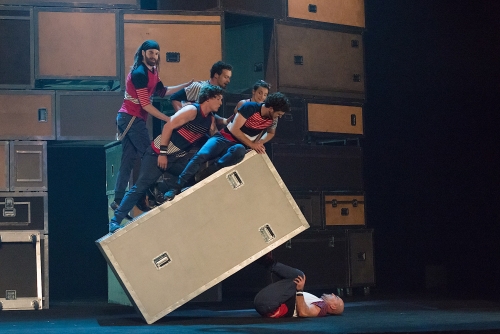Assembly Hall, Edinburgh Festival Fringe; 23rd August 2017

Quebecois circus company Flip FabriQue are back at the Edinburgh Fringe with their second show, Transit, which is good news for those enthralled by their previous work Attrape Moi, as Transit feels like basically the same show with marginally different content.
Centred on a loose theme of ‘journeys’ and with an airport inspired set, the circus skills in Transit are some of the best you are likely to see anywhere. The cast are impressively multi-talented with exceptional levels of timing, competence and group dynamics. The creativity and choreographic play within the the majority of the technical circus acts is delightful, innovative, well executed and to be commended. The energy is high, there are jaw-dropping moments even for an experienced circus viewer; it is clear that these are very skilled artist at the top of their physical game.

Outside of the technical circus however, there are aspects of this production which leave me confused and frustrated.
If pushed to describe the overall performative tone of the piece I would have to go with ‘childish’. I freely admit that I am a massive circus snob, but I am able to appreciate the joy in simplicity of delivery and to see the value in accessible content. As with Attrape Moi, however, Transit feels like a children’s show masquerading under the banner of ‘suitable for all’. In my mind, this is a subtle yet important distinction. The garish costuming, the incessant, inane and irritating verbal chatter, broadly drawn surface characters, and the obtuse and unsophisticated attempts to convey emotions makes me think there is little in this piece for adults beyond the spectacle of the technical circus.

Making circus work for children and families is a noble pursuit, and the kids in the audience certainly loved this show. Perhaps some of my distaste comes simply from the fact that this work is not aimed at me. I readily admit that my tastes are not everyone’s, and many people may see a charm and warmth in this show that I miss.
Outside of my distaste for the delivery however, there are further elements which I feel are so problematic that some attention must be drawn to them.

Firstly (an oldie but a goody), the fact that there is only one very slight woman (Jade Dussault) in a cast alongside five large men is a paradigm that I am so incredibly tired of seeing on international stages. There are many highly talented female circus artists with strong skill sets and they need to be given more opportunities and visibility. Indeed the way that gender role are represented in Transit is deeply troubling. In particular the scene where Dussault climbs atop a flight case, holds a hula hoop aloft, and literally announces ‘look at this’ before performing a slow, spotlit solo to a female lead vocal track while the male cast members stop and gaze up at her. This appears to be done with little shade of irony, and is made even more galling due to its position directly after a highly dynamic, acrobatic, brightly lit male diablo act, thus polarising the ways in which men and women are allowed to perform, be seen, and drive narrative – this hooping routine feels like everything that is wrong with choreographing circus for women within ensembles.
This binary of women’s/men’s disciplines is reinforced when the male cast members all feign terror at touching a hula hoop, then proceed to ape feminine stances to create a parody hooping number (which finally ‘evolves’ into a complex and technical hoop diving act). It might be played for laughs, but this level of reductionism is disappointing to see within international circus.

Most troubling of all, however, is the straps artist who, as his ‘if this were my last show I would…’ moment, performs aerial in a fat suit whilst eating a donut. If done in another context with a well crafted level of performative intent, this could be a strong social statement piece. Here however, it is simply a cheap, juvenile and tawdry attempt to get laughs at the idea of an overweight person undertaking physical activity. There is something deeply unpleasant about a very fit young man putting on a fat suit for no purpose other than to mock the idea of being overweight, and it’s concerning that a successful company with such a high level of programming visibility would choose to do this so blithely.
Maybe I am too much of a sour-face about these issue. Maybe I should let sexism and fat-shaming slide. Maybe I should ‘learn to take a joke’ and not take circus so seriously, especially in a show which is aimed mainly at children. Or maybe companies should up their game and make better work that doesn’t reinforce lazy stereotypes for laughs that could easily be got in other ways, especially since they are so clearly skilled at what they do.
This response was produced as part of the #CircusVoices scheme for developing critical languages around circus arts.




